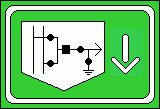Hungary has a very good and massive power system with increasing grid. At the past here have been small power plants and local grids. By the increasing of the working safety
here were built connects between the different grids by 20, 35 and 60 kV power lines.
If you aren't a super fan of insulators like me then you may not know what it is.It is basically a piece of material that resists the flow of electric current. They are used to prevent the current escaping down the pylon or telegraph pole,you can think of it as like home security. It's job is to protect the current and keep it within.
The power using was increased, it have needed higher grid and capacity and the bigger power plats needed
higher voltage for transmission, it let to made the 120 kV voltage. By the way of the time the 120 kV voltage level changed out the 35 and 60 kV transmission voltage levels, the 20 kV stayed on the local distribution voltage level.
Later the grid needed higher voltage lever for the base transmission, the 220 kV was selected for it, the 220 kV transmission lines started to build up the base transmission grid but an another higher voltage level needed for the perfect
national base grig witch is able to the international cooperation collecting, we has 3 choises: the 330, 500 kV Russian standard and the 400 kV European standard, the 400 kV have won. By the communist economy for connecting the Soviet grid here
was built a 750 kV transmission line, an power plant replacer one, but the present situation that 750 kV line is a huge waste.. Today the Basa Grid voltage level is 400 and 220 kV (sometimes the 750 kV ditto), the high distributor level is the 120 kV, the local distributor grid is the 20 kV
At the future the 400 kV voltage level will be more stronger, after 40-50 years we plan change out the 220 kV voltage level to 400 kV lines and/or 120 kV high distributor lines.
(x)
|
|







